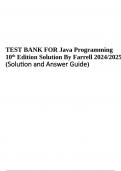Tentamen (uitwerkingen)
109 PAGES APEA 3P Exam Predictor Exam 100% (Best Predictor Exam for 2024/ 2025) (A+ Free
- Vak
- Instelling
APEA 3P Exam Predictor Exam Stuvia Is Available For Download After Purchase. In Case You Encounter Any Difficulties With The Download, Please Feel Free To Reach Out To Me. I Will Promptly Send It To You Through Google Doc or Email. Thank You. APEA 3P Exam Predictor Exam 2024/2025 is your ultim...
[Meer zien]













